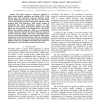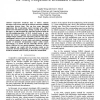317 search results - page 31 / 64 » Bounds on the Gain of Network Coding and Broadcasting in Wir... |
ICC
2007
IEEE
14 years 2 months ago
2007
IEEE
—Slepian-Wolf coding is a promising distributed source coding technique that can completely remove the data redundancy caused by the spatially correlated observations in wireless...
CORR
2008
Springer
13 years 8 months ago
2008
Springer
Distributed space-time block coding is a diversity technique to mitigate the effects of fading in multi-hop wireless networks, where multiple relay stages are used by a source to ...
CORR
2008
Springer
13 years 8 months ago
2008
Springer
This paper presents a cross-layer approach to jointly design adaptive modulation and coding (AMC) at the physical layer and cooperative truncated automatic repeat request (ARQ) pro...
ICC
2007
IEEE
14 years 2 months ago
2007
IEEE
—Cooperative broadcast aims to deliver common messages to all receiver nodes in the wireless network by utilizing cooperation between them. This can have many important applicati...
INFOCOM
2008
IEEE
14 years 2 months ago
2008
IEEE
—We present the first unified modeling framework for the computation of the throughput capacity of random wireless ad hoc networks in which information is disseminated by means...


